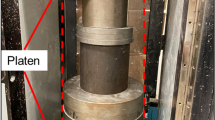Summary
A pillar failure at shallow depth of overburden, featuring the recent formation of subvertical open cracks in the rock was observed. An extensive laboratory test program including Brazilian tests, uniaxial and triaxial compression tests for obtaining strength and deformation characteristics of the limestone was executed. Strength from single and multiple failure triaxial compression tests on intact rock and from tests on small scale rock mass specimens were obtained. Classification of the rock mass was conducted for use with the Hoek-Brown strength criterion. Numerical analysis shows that the strength of the rock mass exceeds by far the applied stress, suggesting a stable pillar. This typical rock engineering approach to assess rock mass stability is shown to be inadequate.
Similar content being viewed by others
Author information
Authors and Affiliations
Rights and permissions
About this article
Cite this article
Alber, M., Heiland, J. Investigation of a Limestone Pillar Failure Part 1: Geology, Laboratory Testing and Numerical Modeling. Rock Mech Rock Engng 34, 167–186 (2001). https://doi.org/10.1007/s006030170007
Issue Date:
DOI: https://doi.org/10.1007/s006030170007




